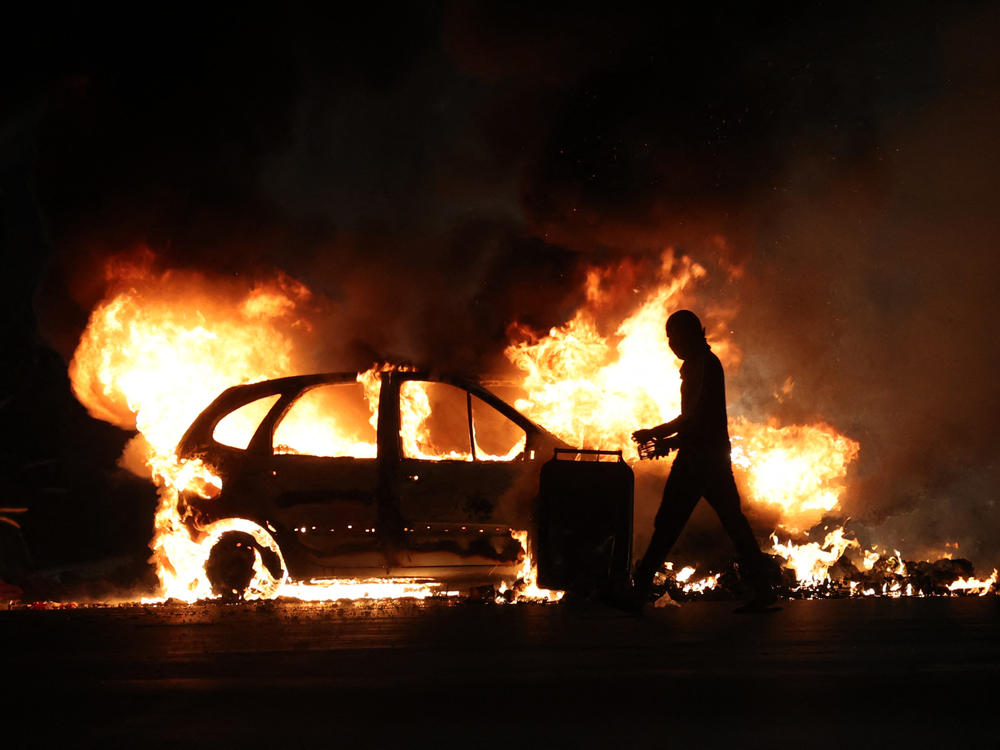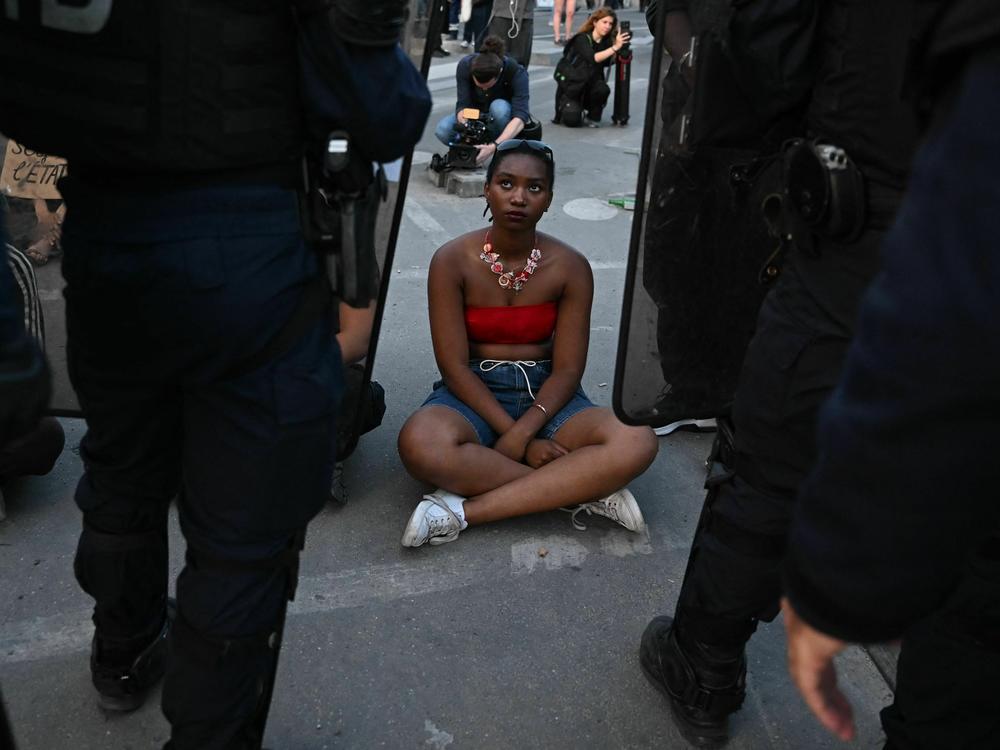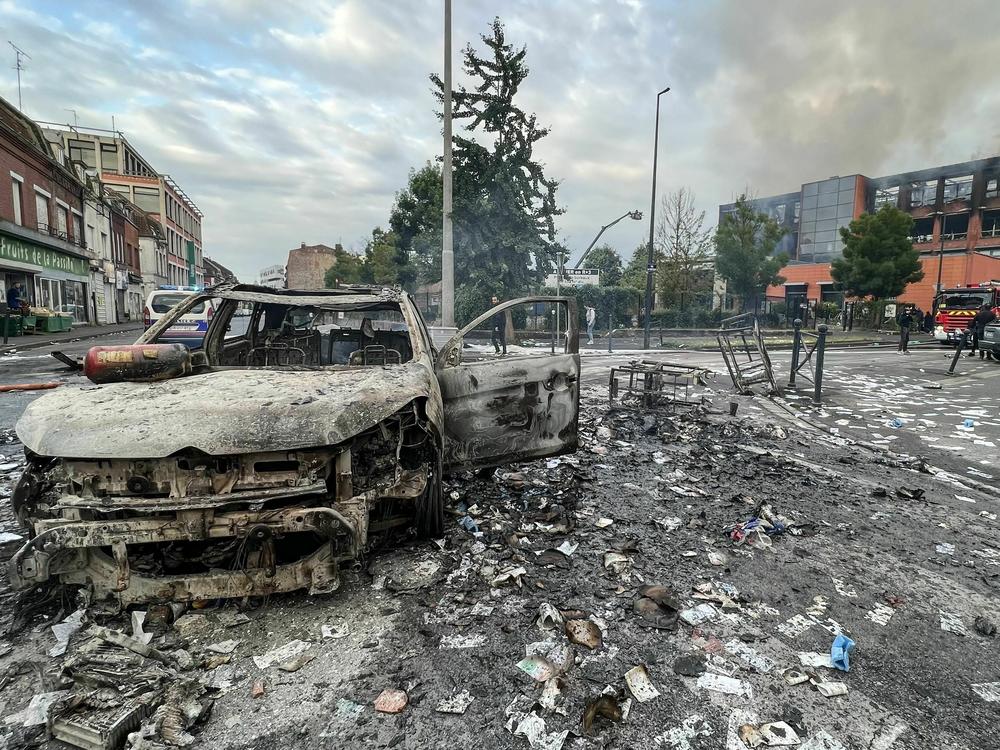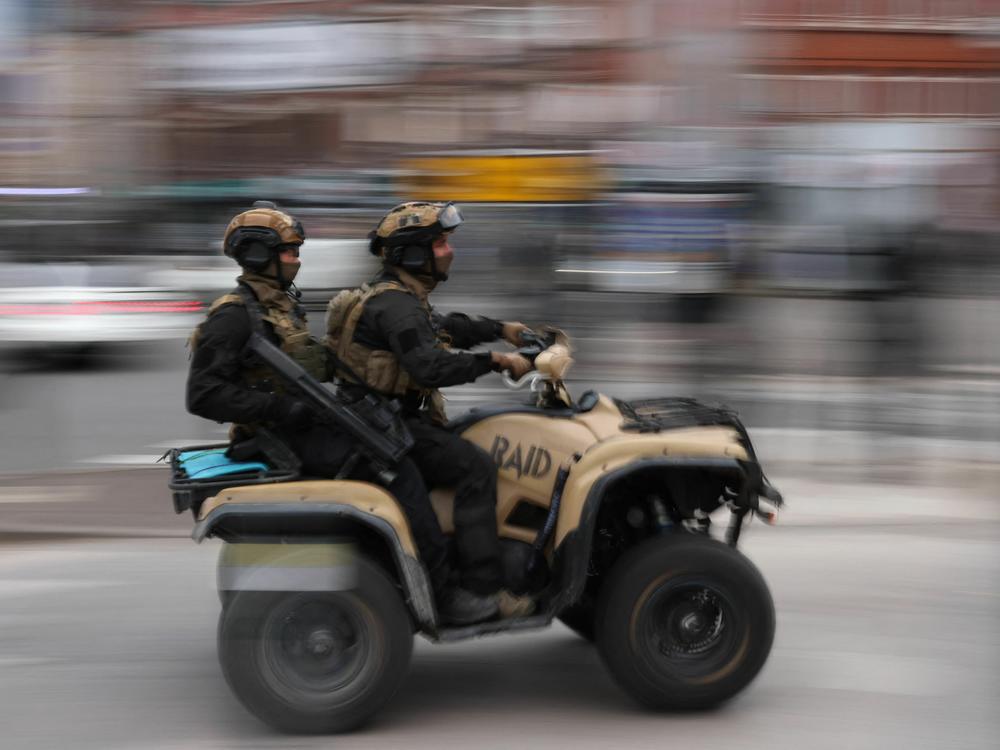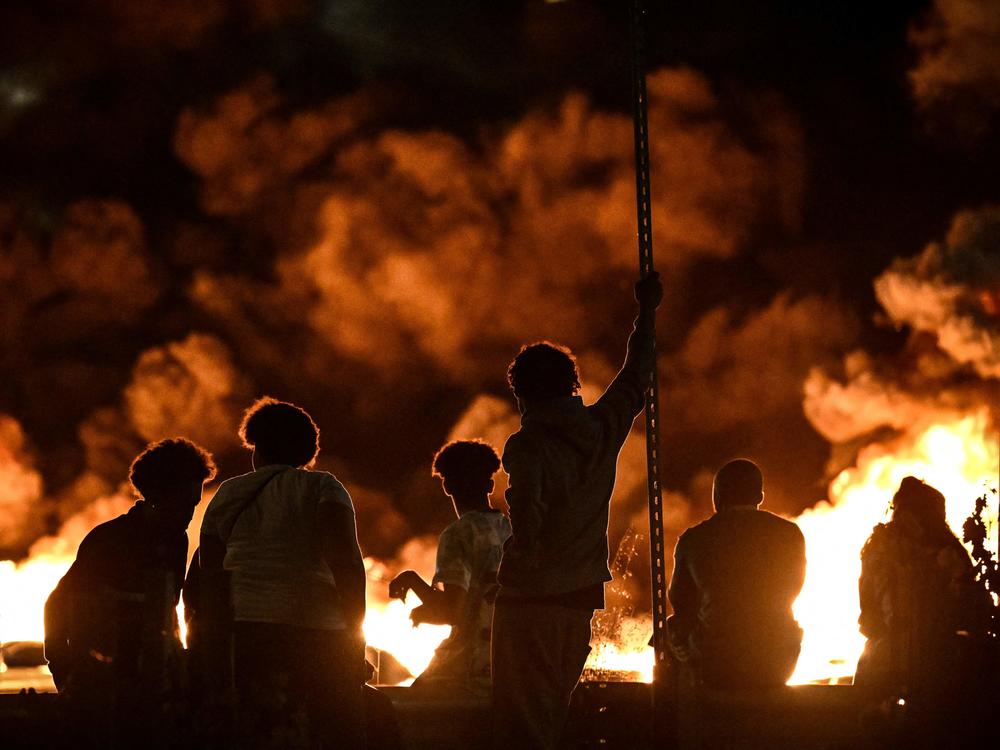Section Branding
Header Content
France is roiled by protests after police killed a teenager. Here's why
Primary Content
Updated July 1, 2023 at 9:21 PM ET
When a police officer shot and killed a teenager named Nahel M. in the Paris suburb of Nanterre on Tuesday, outrage boiled over and spread across France. Protests have gripped big cities, as people call for justice — and riots have also broken out, bringing violence, fires, and hundreds of arrests.
Saturday night appeared calmer than previous days, with France's interior minister reporting 427 arrests as of early Sunday morning local time.
A day earlier, more than 1,300 arrests were made in a night of rioting as 45,000 police officers were deployed around the country in an unsuccessful attempt to curb the violence, the Interior Ministry said earlier Saturday.
The slain 17-year-old's family has not released his surname, only his last initial. A funeral for Nahel was held Saturday in Nanterre.
His killing is now a rallying call, in a similar way that George Floyd's murder by a police officer in Minneapolis in 2020 sparked widespread unrest over the police use of force, particularly against minorities.
Here's what's happening with the protests, and how it all got started.
The teenager was shot Tuesday morning
Similar to the Floyd case in the U.S., videos of Nahel's encounter with police have amplified public anger and distrust, after eyewitnesses and surveillance video contradicted the official narrative.
Nahel was driving a yellow Mercedes when he was shot at close range during a police stop near Nelson Mandela Square around 8 a.m. Tuesday, according to Nanterre Mayor Patrick Jarry.
Footage from several vantage points shows that, despite early claims that two police officers were in grave danger when one of them opened fire, the pair were standing next to the driver's window, with an officer pointing a gun inside, before the car began to move past them.
"You are going to get a bullet in the head," a voice is heard saying, according to the France24 news outlet. As the car moves forward, a single shot is heard. Nahel died at the scene; his car rolled forward, coming to a stop after hitting a utility pole.
Two other people were in the car with Nahel — one has spoken to police, but the other fled the scene and was being sought by law enforcement, Jarry said.
The officer who shot Nahel is in custody
A police officer was taken into custody after the shooting — and on Thursday, prosecutor Pascal Prache announced a preliminary charge of voluntary homicide against the officer, saying that a review found the legal standard for the officer to use his gun had not been met when he fired at Nahel from close range.
The two officers were riding their motorcycles when they attempted to stop the car after seeing it speed through bus lanes, according to France's BFM TV, citing a timeline issued by the prosecutor's office. The car's driver didn't stop until he was cut off by a traffic jam, the prosecutor said.
The officer who acknowledged firing his gun said he did so for a number of reasons, from the desire to stop the vehicle to fears that the car might hit him or someone else, the newspaper La Montagne reported.
But after hearing conflicting versions of events about deadly violence, Green party leader Marine Tondelier was quoted saying, "You get the feeling that our police is becoming like America's."
What do the protesters want?
The chant heard repeatedly is, "Justice pour Nahel," but while the protest center around the teenager's tragic death, demonstrators' demands go further.
"What they are trying to do is seize this moment as an opportunity to open a wider debate about what they see as systemic police abuse, particularly in the working-class suburbs," reporter Rebecca Rosman told NPR from Paris. "There's long been complaints of police brutality and discrimination in these areas, especially against lower-income households and racial minorities.
"Last year, there were 13 people killed after being stopped for traffic violations," Rosman added.
That figure set a record, according to French media.
How are officials reacting?
From the mayor to the president, authorities expressed their condolences and support for Nahel's family, along with a pledge to hold police accountable. But as protests intensified, leaders have increasingly focused on trying to control the crowds and prevent damage, deploying tens of thousands of police.
"A teenager was killed. That is inexplicable and unforgivable," President Emmanuel Macron said Tuesday, during a visit to Marseille.
On Friday, Macron had a different message. After a night in which 875 people were arrested, he called for help in getting the protests under control.
"A third of the people arrested last night are youths, sometimes very young," Macron said, adding, "I call the parents to responsibility."
Interior Minister Gérald Darmanin showed public support for the police and other emergency personnel, issuing a letter thanking them for their restraint.
"As you well know, this minority of delinquents doesn't represent the immense majority of inhabitants of working-class neighborhoods," Darmanin said.
What has the unrest been like?
The first protests took place Tuesday night in Nanterre, and they've spread quickly since then, to communities in the south and north.
"Everyone come, we will lead a revolt for my son," a woman identified as Nahel's mother said in a video circulating on TikTok, according to Reuters.
Some demonstrations and marches have been peaceful. But often, protesters and police have clashed. Protesters have used fireworks and stones to attack police. At one point, officers deployed so much tear gas against crowds in the street that people in the Aillaud Towers complex in Nanterre had to be evacuated, the mayor said.
Jarry and others pleaded with protesters not to damage buildings used by residents for critical services. Two schools have been targeted, he said, and a leisure center and cultural center have been badly damaged or destroyed.
The damages include the Hisez Haut social and cultural center, where Nahel used to go when he was younger.
"Let's stop this violence," the center said on Facebook, "we can't honor Nahel's memory in this way."
A number of French cities are announcing curfews or banning demonstrations outright, as they try to quell violence and destruction.
What do critics say?
Critics say that Macron and other leaders are showing sympathy — but not an intent to examine whether the problems that led to Nahel's death run deeper than a single officer's actions.
Crystal Fleming, a sociology professor at Stony Brook University, noted in an interview with NPR that Macron called the shooting "inexplicable."
"The reality is that it's not inexplicable. It's not rocket science, it's racism," said Fleming, the author of Resurrecting Slavery: Racial Legacies and White Supremacy in France.
Unrest over the killing of Nahel, whose family has Algerian roots, is "about something much bigger," she said, adding, "In any society, the policing that we see, and discrimination that takes place, reflects the biases of that society and that society's history."
Citing France's history of colonial and racist behavior toward Arabs and Black people, Fleming added, "So it really matters that this boy who was killed was North African — French North African."
Copyright 2023 NPR. To see more, visit https://www.npr.org.
